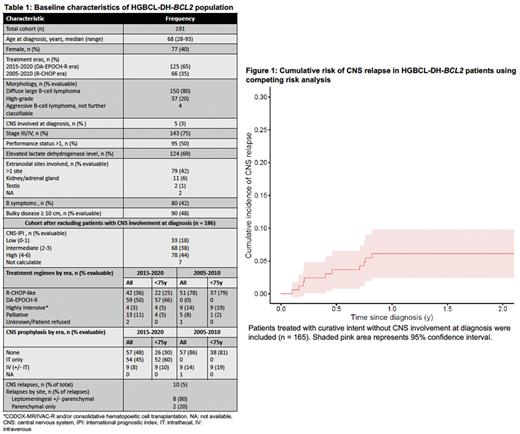Abstract
Introduction: Secondary central nervous system (CNS) involvement in aggressive B-cell lymphoma (SCNSL) is associated with dismal outcomes, highlighting the need to identify at-risk patients (pts). High-grade B-cell lymphoma with MYC and BCL2 rearrangements (HGBCL-DH-BCL2) is a cytogenetically-defined entity associated with poor outcomes, partly attributed to a high rate of SCNSL. However, historic estimates of SCNSL vary widely across studies, confounded by selective fluorescence in situ hybridization (FISH) testing. The CNS International Prognostic Index (CNS-IPI) is a robust model used to estimate the risk of CNS relapse in de novo diffuse large B-cell lymphoma (DLBCL). However, it has not yet been applied to HGBCL-DH-BCL2. Here we performed a population-based analysis to determine the rates of SCNSL in HGBCL-DH-BCL2 identified by non-selective FISH testing in British Columbia (BC) stratified by the CNS-IPI.
Methods: All HGBCL-DH-BCL2 pts diagnosed in BC since the introduction of routine FISH testing in all de novo aggressive B-cell lymphoma biopsies and provincial guidelines implementing treatment with dose-adjusted etoposide, doxorubicin, vincristine, cyclophosphamide, prednisone and rituximab (DA-EPOCH-R) with intrathecal methotrexate (IT-MTX) CNS prophylaxis for appropriately fit HGBCL-DH-BCL2 pts aged ≤75 years (y) (DA-EPOCH-R era: 2015-2020) were included. The cohort was supplemented with HGBCL-DH-BCL2 pts from a historic province-wide cohort of aggressive B-cell lymphoma with FISH performed on all evaluable diagnostic biopsies in a research setting (R-CHOP era: 2005-2010). Time to CNS relapse was measured from the date of diagnosis accounting for the competing risk of death from other causes. Biopsies underwent institutional pathology review for consensus assignment to DLBCL or high-grade (HG) morphology.
Results: 191 pts with HGBCL-DH-BCL2 were identified (DA-EPOCH-R era n =125, R-CHOP era n = 66). Median (interquartile range) follow up of alive pts was 3.3y (2.3-4.7y) in the DA-EPOCH-R era and 11.9y (11.4-13.2y) in the R-CHOP era. Baseline characteristics are shown in Table 1. Five (3%) pts had CNS involvement at diagnosis (4 DLBCL and 1 HG morphology). Excluding pts with CNS involvement at diagnosis, the 2y cumulative risk of CNS relapse in all HGBCL-DH-BCL2 pts treated with curative intent was 6% (Figure 1), and estimates were 5.5% and 11% in DLBCL and HG morphologies, respectively (p= 0.2). Leptomeningeal involvement was found in 8/10 (80%) of CNS relapses. High CNS-IPI (> 4) was observed in 44% of pts and was associated with a significantly higher rate of CNS relapse (12% high vs < 5% low/intermediate (int) CNS-IPI, p = 0.04). CNS-IPI was also predictive in those with DLBCL morphology (p=0.02). Limited by a small number of events, of the 3/27 pts with HG morphology that developed CNS relapse, 2 had high CNS-IPI and 1 had int CNS-IPI. CNS prophylaxis did not impact CNS relapse risk in either the entire group or when restricting the analysis to pts with high CNS-IPI. CNS relapse was similar in those treated with R-CHOP or DA-EPOCH-R (p = 0.6). To minimize potential bias introduced by treatment selection, we performed an era-on-era comparison in pts aged ≤75y at diagnosis to determine whether the introduction of DA-EPOCH-R with integrated IT-MTX, was associated with a decrease in CNS relapse risk. 79% of pts received R-CHOP in the R-CHOP era whereas 66% of pts received DA-EPOCH-R in the DA-EPOCH-R era. There were no significant differences in CNS-IPI distribution or morphology proportions between the two eras. Competing risk regression analysis found no significant difference in CNS relapse risk between the two eras after adjusting for morphology (hazard ratio and 95% confidence interval of DA-EPOCH-R vs R-CHOP era: 0.47 (0.12-1.84), p = 0.3).
Conclusions: In the largest series to date examining SCNSL in HGBCL-DH-BCL2 identified through routine FISH testing, SCNSL rates are considerably lower than previously reported. For those with CNS relapse, leptomeningeal involvement was frequent. The CNS-IPI remains predictive of SCNSL in this entity, suggesting that the overall risk is driven by additional clinical risk factors. Further, as the CNS relapse risk is <5% in pts with low/int CNS-IPI, CNS-directed procedures and prophylaxis may not be required in this subset. Larger series are required to examine the impact of treatment regimen on CNS relapse risk.
Disclosures
Villa:AstraZeneca, Roche: Research Funding; Roche, AstraZeneca, Abbvie, Janssen, Kite/Gilead, BMS/Celgene, BeiGene, Kyowa Kirin: Consultancy, Honoraria. Craig:BeiGene: Honoraria; Bayer: Consultancy. Gerrie:AbbVie: Honoraria, Research Funding; Janssen: Honoraria, Research Funding; AstraZeneca: Honoraria, Research Funding; Sandoz: Honoraria. Freeman:Janssen: Honoraria, Research Funding; Sanofi: Honoraria; Incyte: Honoraria; Amgen: Honoraria; Bristol Meyers Squibb: Honoraria, Membership on an entity's Board of Directors or advisory committees. Steidl:Abbvie: Consultancy; Bayer: Consultancy; Bristol Myers Squibb: Consultancy; Curis Inc: Consultancy; Epizyme: Research Funding; Roche: Consultancy; Seattle Genetics: Consultancy; Trillium Therapeutics: Research Funding. Sehn:AbbVie, Acerta, Amgen, Apobiologix, AstraZeneca, BMS/Celgene, Gilead, Incyte, Janssen, Kite, Karyopharm, Lundbeck, Merck, Morphosys, Sandoz, Seattle Genetics, Servier, Takeda, TG Therapeutics, Verastem: Honoraria; Teva, Roche/Genentech: Consultancy, Honoraria, Research Funding; Chugai: Consultancy, Honoraria; AbbVie, Acerta, Amgen, Apobiologix, AstraZeneca, BMS/Celgene, Debiopharm, Genmab, Gilead, Incyte, Janssen, Kite, Karyopharm, Lundbeck, Merck, Morphosys, Novartis, Sandoz, Seattle Genetics, Servier, Takeda, TG Therapeutics, Verastem: Consultancy. Scott:AstraZeneca: Consultancy, Honoraria; NanoString: Patents & Royalties; Roche: Research Funding; Incyte: Consultancy; Janssen: Consultancy, Research Funding; Abbvie: Consultancy. Savage:Beigene and Regeneron: Membership on an entity's Board of Directors or advisory committees; BMS, Janssen, Kyowa, Merck, Novartis, and Seattle Genetics: Consultancy, Membership on an entity's Board of Directors or advisory committees.
Author notes
Asterisk with author names denotes non-ASH members.


This feature is available to Subscribers Only
Sign In or Create an Account Close Modal